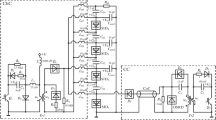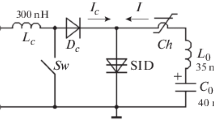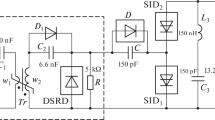Abstract
The results from studies of a high-voltage unit of shock-ionized dynistors in the switching mode of current pulses with an amplitude of several kiloamperes and a rise rate of up to 100 kA/μs are presented. The control circuit of this unit with a front sharpener of the trigger voltage pulses is described, which provides a significant reduction in energy losses in dynistors.
Similar content being viewed by others
Avoid common mistakes on your manuscript.
The efficiency of generators of rapidly rising current pulses with capacitive energy storage depends significantly on the energy losses in the closing switches, which are determined by the time they are turned on in a state with high conductivity. In this regard, modern thyristor-type semiconductor switches have good prospects for use since they have a fairly short switching time to a well-conducting state. At present, thyristor-type silicon switches (TSS), which are switched as a result of impact ionization of silicon, described in [1–4] have the shortest switching time from the nonconducting state to the high-conducting state. In these switches, the process of impact ionization is initiated by the method proposed in [5], which consists in applying a nanosecond high-voltage pulse, the amplitude of which significantly exceeds the steady-state breakdown voltage of the semiconductor structure of the TSS. Impact ionization provides very fast generation of electron-hole plasma. As a result, the high conductivity of the TSS is achieved within a time of <1 ns, which decreases with an increase in the rate of rise of the triggering voltage. Such a short time of switching to a well-conducting state determines record low energy losses during switching of nanosecond current pulses. The undoubted advantages of TSS include the fact that, when connected in series, they can be switched on by a common high-voltage triggering pulse.
This article describes the studies of a high-voltage unit of shock-ionized dynistors (SID) [6] carried out in order to increase its efficiency. The SID design was developed as a result of optimization of known TSS. Studies [7–9] show that it provides efficient SID switching at a relatively low power of the trigger pulse.
The SID unit with an operating voltage of 12 kV was studied. Its switching was carried out using a control circuit widely used to start TSS, which contained a starting generator with an inductive energy storage and a current interrupter in the form of a unit of series-connected drift step recovery diodes (DSRD) [10]. Since the voltage on the SID unit at the moment of switching on is high, the DSRD unit had a high operating voltage and consisted of high-voltage diodes with a steady-state breakdown voltage of 1.2 kV, which could not provide the front of triggering pulses less than 3 ns.
The aim of our work was to study the possibility of reducing switching energy losses in the SID unit by reducing the front of the trigger voltage pulses using a high-voltage sharpener based on SID with a small working area.
The studies were carried out on an experimental setup, which was built according to the scheme shown in Fig. 1. The setup consisted of a main circuit containing a capacitor C0, choke L0, and the main SID unit as well as the dividing circuit C–D and coaxial cable CC. Switching of the SID unit was carried out using the control circuit of the control unit (CU), which contained the DSRD block, peaking unit SIDc, and starting generator G. In SID and SIDc, we used six and three series-connected dynistors with a steady-state breakdown voltage of 2.5 kV, respectively, which had a structure diameter of 24 and 7 mm, respectively. The DSRD unit consisted of 35 diodes with a structure diameter of 16 mm.
The setup’s principle of operation is as follows. The initial state of the capacitor C0 is charged to voltage U0. This voltage is applied to the SID unit. Circuit C–D and resistor R eliminate the possibility of stress U0 to the SIDc–DSRD circuit. The process of generating the start pulse of the SID unit begins after the generator G is turned on, which was previously described in [11]. First, a current pulse is passed through the DSRD unit in the forward direction. It has a fundamentally short duration (~350 ns) and provides charge accumulation in diodes. At the end of the forward current, a rapidly increasing reverse current is passed through the DSRD unit, which carries out the removal of the entire accumulated charge in a time of ~150 ns. As a result, the diodes of the DSRD unit are turned off, and the I current flowing through the generator G is switched to the SIDc unit. In this case, the capacitances of the dynistors themselves of this unit are quickly charged, and the voltage on the SIDc unit increases sharply. When the voltage on the SIDc reaches a value sufficient for impact ionization of dynistor structures, it turns on in <1 ns. After turning on the SIDc unit, current I is switched to the coaxial cable CC. As a result, a voltage pulse is formed at the cable input Uin, whose amplitude is determined by the product of the current I on the wave impedance of the cable. Voltage pulse amplitude Uout at the cable output depends on the switching voltage of the SID unit and can reach 2Uin.
Rapidly rising voltage Uout is applied to the circuit C–D and to the SID unit. As a result, the control current Ic flows through the capacitance of the SID unit Ic itself and charges this capacity. As a result, the voltage on the SID unit rises sharply to a value sufficient to turn it on. In the process of starting the SID unit, the choke L0 has a large inductance and eliminates the possibility of current redistribution Ic into the power circuit. After turning on the SID unit, current Ic continues to flow through it, which maintains high conductivity of dynistors until the core of the choke L0 is saturated. The core of the choke L0 saturates a few nanoseconds after the SID unit is turned on. In this case, the inductance of the choke decreases sharply, and a rapidly increasing current I0 flows through the SID unit.
In the process of research, currents I and I0 and voltage U on the SID unit were measured. For measuring currents I and I0, we used a Tektronix TDS 3052C oscilloscope with 500 MHz bandwidth and Pearson current monitor 410 current sensors. Voltage measurement of U was carried out using a Tektronix DPO 5204 oscilloscope with 2 GHz bandwidth and a homemade low-resistance divider, which was connected to the SID unit through a separating capacitor. The design of the divider is described in many works, for example, in [12]. The lower arm of the divider was a coaxial cable with a characteristic impedance of 50 Ω. A partially shielded, small-sized resistor with a resistance of 470 Ω was used as the upper arm. The divider was calibrated using voltage pulses with a front of 0.3 ns, which were formed using a I1-15 generator. As a result of optimizing the screen length of the high-side resistor, it was possible to reliably measure signals with a rise time of 0.5 ns.
Figure 2 shows voltage waveforms on the SID unit, illustrating the process of its switching when using the SIDc unit sharpening the front of the trigger voltage (curves with index 1) and without the SIDc unit (curves with index 2). They are obtained with the main circuit disconnected. Oscillograms in Figs. 2a and 2b correspond to currents I with an amplitude of 300 and 200 A, respectively.
As can be seen from the oscillograms, the voltage on the SID unit at the moment of its switching on is more than 20 kV. It significantly exceeds the value of the total stationary breakdown voltage of the six used dynistors (15 kV). This result is due to the fact that the stationary breakdown in dynistor structures does not have enough time to develop during the rise of the trigger voltage. The sharpener allows one to increase the rise rate of the trigger voltage on the SID unit. In this case, the SID unit is turned on at a higher voltage, which determines a higher intensity of impact ionization processes in dynistor structures. As a result, the turn-on time of the SID unit is reduced and its conductivity after switching is increased. The turn-on voltage of the SID unit increases slightly, but this is enough to significantly increase its efficiency.
Figure 3 shows the voltage waveforms on the SID unit during the main current flow, obtained in the setup (see Fig. 1) when charging the capacitor C0 up to a voltage of 12 kV. Oscillograms in Fig. 3a correspond to experiments with the SIDc sharpener in the control circuit of the CU. Oscillograms in Fig. 3b were obtained without a sharpener. Curves with indices 1 and 2 correspond to the current I with an amplitude of 300 and 200 A, respectively.
Oscillograms of voltage on the SID unit and main current I0 (a) when using sharpener and (b) without sharpener. Curves with indices 1 and 2 correspond to the current I with an amplitude of 300 and 200 A, respectively. Vertical scale: current—500 A/division, voltage—5 kV/division; horizontally—50 ns/division.
According to the oscillograms, the increase in the rise rate of the trigger voltage, obtained by using the sharpener, ensures a reduction in energy losses in the SID unit when switching the main current pulses I0. The influence of the sharpener increases with decreasing current I. Thus, at I = 300 A, current amplitude I0 when using a sharpener is ~2.65 kA and without a sharpener ~ 2.5 kA; when I = 200 A, it is ~2.5 kA and ~2.25 kA, respectively.
Figure 4 shows the oscillogram of the main current obtained in experiments when no resistor R0 was used in the considered setup, and the capacitance of the capacitor C0 was increased to 88 nF. The charging voltage of the capacito C0 was 12 kV. Switching of the SID unit was carried out by a control circuit with a sharpening SIDc unit at current I with an amplitude of 300 A.
According to the oscillogram in Fig. 4, the maximum amplitude and rise rate of the main current are 10 kA and 100 kA/μs, respectively. The low attenuation of the main current indicates low energy losses in the discharge circuit of the capacitor C0. The amplitude of the first half-wave of the main current (Im1) is 1.18 times greater than the amplitude of the second half-wave (Im2). The efficiency of the switching process determined from the relation (Im2/Im1)2 is ~72%.
Thus, the studies performed have shown that the developed SID unit is able to effectively switch powerful nanosecond current pulses that increase at a rate of tens of kiloamperes per microsecond. Energy losses in the SID unit are significantly reduced even with a slight increase in the rise rate of the trigger voltage.
Change history
26 April 2023
An Erratum to this paper has been published: https://doi.org/10.1134/S002044122301030X
REFERENCES
Efanov, V., Kardo-Sysoev, A., Tchashnicov, I., and Yarin, P., Proc. 22nd Int. Power Modulator Symposium, Boca Raton, FL, 1996, p. 225. https://doi.org/10.1109/MODSYM.1996.564440
Grekhov, I., Korotkov, S., and Rodin, S., IEEE Trans. Plasma Sci., 2008, vol. 36, no. 2, part 1, p. 378. https://doi.org/10.1109/TPS.2008.918661
Korotkov, S.V., Aristov, Yu.V., Voronkov, V.B., Zhmodikov, A.L., Korotkov, D.A., and Lyublinskii, A.G., Instrum. Exp. Tech., 2009, vol. 52, no. 5, pp. 695–698. https://doi.org/10.1134/S0020441209050091
Gusev, A.I., Lyubutin, S.K., Rukin, S.N., and Tsyranov, S.N., IEEE Trans. Plasma Sci., 2016, vol. 44, no. 10, part 1, p. 1888. https://doi.org/10.1109/TPS.2016.2542343
Grekhov, I. and Kardo-Sysoev, A., Sov. Tech. Phys. Lett., 1979, vol. 5, no. 8, p. 395.
Korotkov, S.V., RF Minor Patent 197597, Byull. Izobret., 2020, no. 14.
Korotkov, S.V., Aristov, Yu.V., and Voronkov, V.B., Instrum. Exp. Tech., 2019, vol. 62, no. 2, pp. 165–168. https://doi.org/10.1134/S0020441219010111
Korotkov, S.V., Aristov, Yu.V., Zhmodikov, A.L., and Korotkov, D.A., Instrum. Exp. Tech., 2020, vol. 63, no. 5, pp. 683–688. https://doi.org/10.1134/S0020441220050176
Korotkov, S.V., Aristov, Yu.V., Korotkov, D.A., and Zhmodikov, A.L., Rev. Sci. Instrum., 2020, vol. 91, p. 084704. https://doi.org/10.1063/5.0015284
Grekhov, I., Efanov, V., Kardo-Sysoev, A., and Shenderey, S., Solid-State Electron., 1985, vol. 28, no. 6, p. 597.
Korotkov, S.V., Aristov, Yu.V., and Korotkov, D.A., Instrum. Exp. Tech., 2020 (in press).
Belkin, V.S. and Shul’zhenko, G.I., Preprint of Institute of Nuclear Physics of the Siberian Branch of the USSR Acad. Sci., Novosibirsk, 1991, no. 91-51.
Author information
Authors and Affiliations
Corresponding author
Additional information
The original online version of this article was revised: Due to a retrospective Open Access order.
Rights and permissions
Open Access. This article is licensed under a Creative Commons Attribution 4.0 International License, which permits use, sharing, adaptation, distribution and reproduction in any medium or format, as long as you give appropriate credit to the original author(s) and the source, provide a link to the Creative Commons license, and indicate if changes were made. The images or other third party material in this article are included in the article’s Creative Commons license, unless indicated otherwise in a credit line to the material. If material is not included in the article’s Creative Commons license and your intended use is not permitted by statutory regulation or exceeds the permitted use, you will need to obtain permission directly from the copyright holder. To view a copy of this license, visit http://creativecommons.org/licenses/by/4.0/.
About this article
Cite this article
Korotkov, S.V., Aristov, Y.V. A Unit of Shock-Ionized Dynistors with a High-Voltage Pulse Sharpener in the Control Circuit. Instrum Exp Tech 65, 745–749 (2022). https://doi.org/10.1134/S0020441222050062
Received:
Revised:
Accepted:
Published:
Issue Date:
DOI: https://doi.org/10.1134/S0020441222050062








